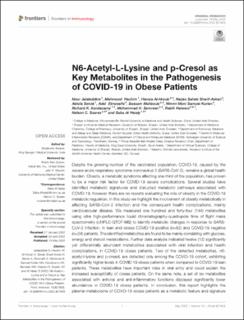| dc.contributor.author | Jalaleddine, Nour | |
| dc.contributor.author | Hachim, Mahmood | |
| dc.contributor.author | Al-Hroub, Hamza | |
| dc.contributor.author | Saheb Sharif-Askari, Narjes | |
| dc.contributor.author | Senok, Abiola | |
| dc.contributor.author | Elmoselhi, Adel | |
| dc.contributor.author | Mahboub, Bassam | |
| dc.contributor.author | Samuel Kurien, Nimmi Moni | |
| dc.contributor.author | Kandasamy, Richard Kumaran | |
| dc.contributor.author | Semreen, Mohammad H. | |
| dc.contributor.author | Halwani, Rabih | |
| dc.contributor.author | Soares, Nelson C. | |
| dc.contributor.author | Al Heialy, Saba | |
| dc.date.accessioned | 2023-02-06T15:02:31Z | |
| dc.date.available | 2023-02-06T15:02:31Z | |
| dc.date.created | 2022-09-08T14:33:27Z | |
| dc.date.issued | 2022 | |
| dc.identifier.citation | Frontiers in Immunology. 2022, 13 . | en_US |
| dc.identifier.issn | 1664-3224 | |
| dc.identifier.uri | https://hdl.handle.net/11250/3048686 | |
| dc.description.abstract | Despite the growing number of the vaccinated population, COVID-19, caused by the severe acute respiratory syndrome coronavirus 2 (SARS-CoV-2), remains a global health burden. Obesity, a metabolic syndrome affecting one-third of the population, has proven to be a major risk factor for COVID-19 severe complications. Several studies have identified metabolic signatures and disrupted metabolic pathways associated with COVID-19, however there are no reports evaluating the role of obesity in the COVID-19 metabolic regulation. In this study we highlight the involvement of obesity metabolically in affecting SARS-CoV-2 infection and the consequent health complications, mainly cardiovascular disease. We measured one hundred and forty-four (144) metabolites using ultra high-performance liquid chromatography-quadrupole time of flight mass spectrometry (UHPLC-QTOF-MS) to identify metabolic changes in response to SARS-CoV-2 infection, in lean and obese COVID-19 positive (n=82) and COVID-19 negative (n=24) patients. The identified metabolites are found to be mainly correlating with glucose, energy and steroid metabolisms. Further data analysis indicated twelve (12) significantly yet differentially abundant metabolites associated with viral infection and health complications, in COVID-19 obese patients. Two of the detected metabolites, n6-acetyl-l-lysine and p-cresol, are detected only among the COVID-19 cohort, exhibiting significantly higher levels in COVID-19 obese patients when compared to COVID-19 lean patients. These metabolites have important roles in viral entry and could explain the increased susceptibility of obese patients. On the same note, a set of six metabolites associated with antiviral and anti-inflammatory functions displayed significantly lower abundance in COVID-19 obese patients. In conclusion, this report highlights the plasma metabolome of COVID-19 obese patients as a metabolic feature and signature to help improve clinical outcomes. We propose n6-acetyl-l-lysine and p-cresol as potential metabolic markers which warrant further investigations to better understand their involvement in different metabolic pathways in COVID-19. | en_US |
| dc.language.iso | eng | en_US |
| dc.publisher | Frontiers Media | en_US |
| dc.rights | Navngivelse 4.0 Internasjonal | * |
| dc.rights.uri | http://creativecommons.org/licenses/by/4.0/deed.no | * |
| dc.title | N6-Acetyl-L-Lysine and p-Cresol as Key Metabolites in the Pathogenesis of COVID-19 in Obese Patients | en_US |
| dc.title.alternative | N6-Acetyl-L-Lysine and p-Cresol as Key Metabolites in the Pathogenesis of COVID-19 in Obese Patients | en_US |
| dc.type | Peer reviewed | en_US |
| dc.type | Journal article | en_US |
| dc.description.version | publishedVersion | en_US |
| dc.source.pagenumber | 11 | en_US |
| dc.source.volume | 13 | en_US |
| dc.source.journal | Frontiers in Immunology | en_US |
| dc.identifier.doi | 10.3389/fimmu.2022.827603 | |
| dc.identifier.cristin | 2049989 | |
| dc.relation.project | Norges forskningsråd: 223255 | en_US |
| cristin.ispublished | true | |
| cristin.fulltext | original | |
| cristin.qualitycode | 1 | |

